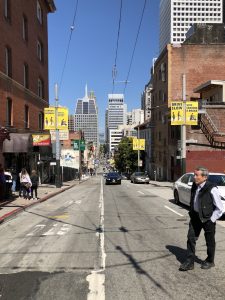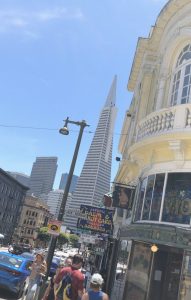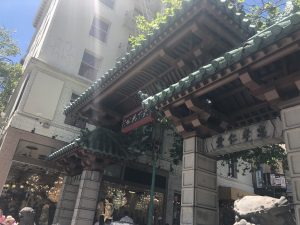My internship this summer is located in San Francisco, California. As San Francisco is part of the United States, the official language spoken here is English. When I first arrived in the city, everything I saw is exclusively in English—from the instructions inside the airport to the signs of Peet’s Coffee.
However, as I have spent more days in the city, I gradually find out that Chinese (both Mandarin and Cantonese) and Spanish also plays significant roles in the linguistic landscape of San Francisco. The traffic sign “drive slow, give seniors a brake” is translated to both Chinese and Spanish on the street.

According to the research by United States Census Bureau in 2012, San Francisco’s population of 805,235 consists of 35.8 percent Asian Americans, with the largest subgroup being Chinese descent at 21.4 percent. The City’s white population is 48.5 percent and Latinos are at 15.1 percent(Fagan, 2012).
As an international student coming from China, I pay close attention to the appearance of Chinese signages around both my living neighborhood and my working place. After spending weekends exploring the city, I found out that there is a large Chinatown located next to the financial district of San Francisco, with an total area of approximately twenty square blocks. Most of the Chinese restaurants, souvenir shops, and community schools concentrate inside the Chinatown. Furthermore, it is not rare to spot individual Chinese signages far away from Chinatown. As Leeman and Modan state, “linguistic landscapes, like other landscapes, are subjective representations rather than objective physical environment.” The large use of Chinese in the area proves the prevailing usage of Chinese as a cultural symbol and the additional commercial value behind that. It becomes more and more common to see groups of “foreigners” visiting Chinatown, which is treated as one of the most popular sightseeing places in San Francisco.


My boss, who was an one-year exchange student at a Chinese University and can speak pretty fluent Chinese, told me that even though he has just been in San Francisco for a few years, he witnesses the steady growth of Chinese signage and Chinese element as part of the linguistic landscape of San Francisco. He says that more and more Chinese businesses, alone with those ones that are non-Chinese but would like to add Chinese elements, pop up in the city as a result of the “commodity of ethnicity”(Leeman and Modan, 2009). My boss himself would sometimes be attracted by the Chinese banners or signs and walk into some Chinese restaurants to experience some “culture-based” food.
From what I have seen in the city of San Francisco and what I heard from my boss, I believe that the Chinese will contribute more to the linguistic landscape of San Francisco in the future. The linguistic landscape of San Francisco will be a mix of multiple languages lead by English and Chinese.
Works Cited:
Fagan, Kevin. “Asian Population Swells In Bay Area, State, Nation”. Sfgate, 2012, https://www.sfgate.com/bayarea/article/Asian-population-swells-in-Bay-Area-state-nation-3425777.php.
Leeman, J., & Modan, G. (2009). Commodified language in Chinatown: A contextualized approach to linguistic landscape1. Journal of Sociolinguistics, 13(3), 332-362.
I really enjoyed reading your linguistic landscape! Although I have never been to San Francisco before, the information about the demographics was really useful; it helped to provide context as to why the presence of the Chinese language was growing in SF. It was also fantastic that you had included the perspective of your boss, who added an unique insight to your linguistic landscape. It would be really interesting if you ever visit SF in the future to see if there were any differences. Great job and hope you are having an incredible internship!
Hi Bill,
Thank you for a very well written and insightful post. Having been to San Francisco myself in the past year, I also was fortunate enough to visit China Town. I found it very interesting how you connected the prevalence and growing popularity of China Town to the idea of “cultural commodity”. According to the authors, a linguistic landscape is “used to both to frame public space and to legitimate the appropriation of that space by private and commercial interests” (Leeman and Modan, 338). I found this to also be true here in Dublin, where I was able to see how the use of Gaelic helped promote not only pride in Irish heritage, but also promote the area’s popularity and tourism.